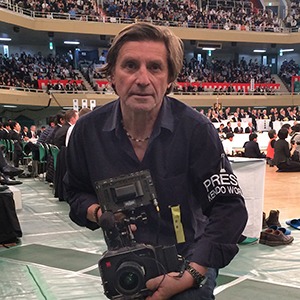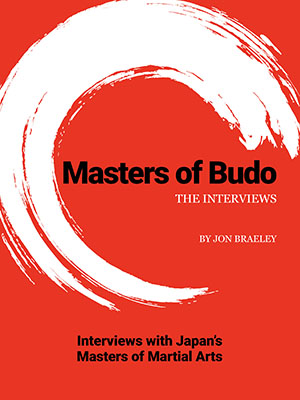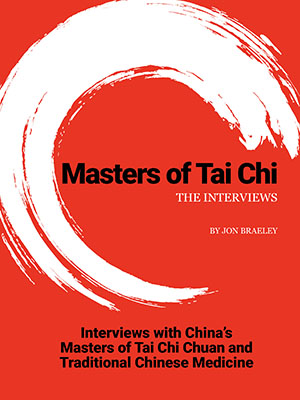The Interview: Master Cui Ruibin and assistant
Note: Please see Part One Introduction
Can you tell us about the lineage of your martial art?
Cui Ruibin: Only Wang Xiangzhai understood and received the Kungfu of Guo Yunsheng and he formed a new style of martial arts on the basis of this traditional one. Master Wang Xiangzhai taught the Kungfu to my teacher, Yao Zongxin. I started practicing martial arts in 1968, majoring in this martial art of Yiquan (Mind Fist). However, my first sifu is not Yao Zongxin, but was a student of his. Then in 1972, I was recommended to Master Yao, and learned Yiquan from him until he died. Yao Zongxin taught me for 13 years, and then after his passing I practiced by myself and have kept on practicing it.
This martial arts school received permission to open in 1994, and we finished the construction at the end of 1995. The students are not only Chinese but from everywhere in the world. I think it is the long history and fantastic culture of Chinese martial arts that is the strong attraction for students of different nationalities to come to China. This includes England, France, Germany, U.S., Sweden, Spain, Malaysia, Hong Kong and Singapore.
Is your school set up to make a profit?
Cui Ruibin: No, it is not the goal. The main purpose of this school is to inherit and spread the great tradition of Chinese martial arts. However, as a company, we have some employees and we have to make a living first. On the basis of fulfilling our need to live, we do try to get contributions, or we can say it is a charity the same as Buddhism always says, to the society.
For example, we have made education in martial arts compulsory for decades. That is to say, we taught Kungfu free of charge, and there are tens of thousands of students who have already got this free education. We set a spot for free classes in the Taoranting Park in Beijing. We started the free classes in the 1980s, and until now, we stayed with it for more than 20 years. We have some teachers there, including myself. That is our location of free classes in Beijing and I believe it is the only one like it in Beijing. Many people who want to learn martial arts know this park and go there. There are some other similar locations in many other parts of China, where some offer free classes, and others charge very low fees for their classes. Our purpose is just to spread the martial art of Yiquan (Mind Fist).
This school is a private one, it is owned by me (Cui Ruibin). I raised the money from lots of channels, including my relatives, friends, a few of my students, and other people who just love martial arts.
This school is under the leadership of the Beijing Martial Arts Association. I am a member of both the Beijing Martial Arts Association, and also the Traditional Martial Arts Association of China. Our school’s name is the International Yiquan Training Center of the Beijing Martial Arts Association. It is one of the few martial arts schools that is directly affiliated to the Beijing Martial Arts Association.
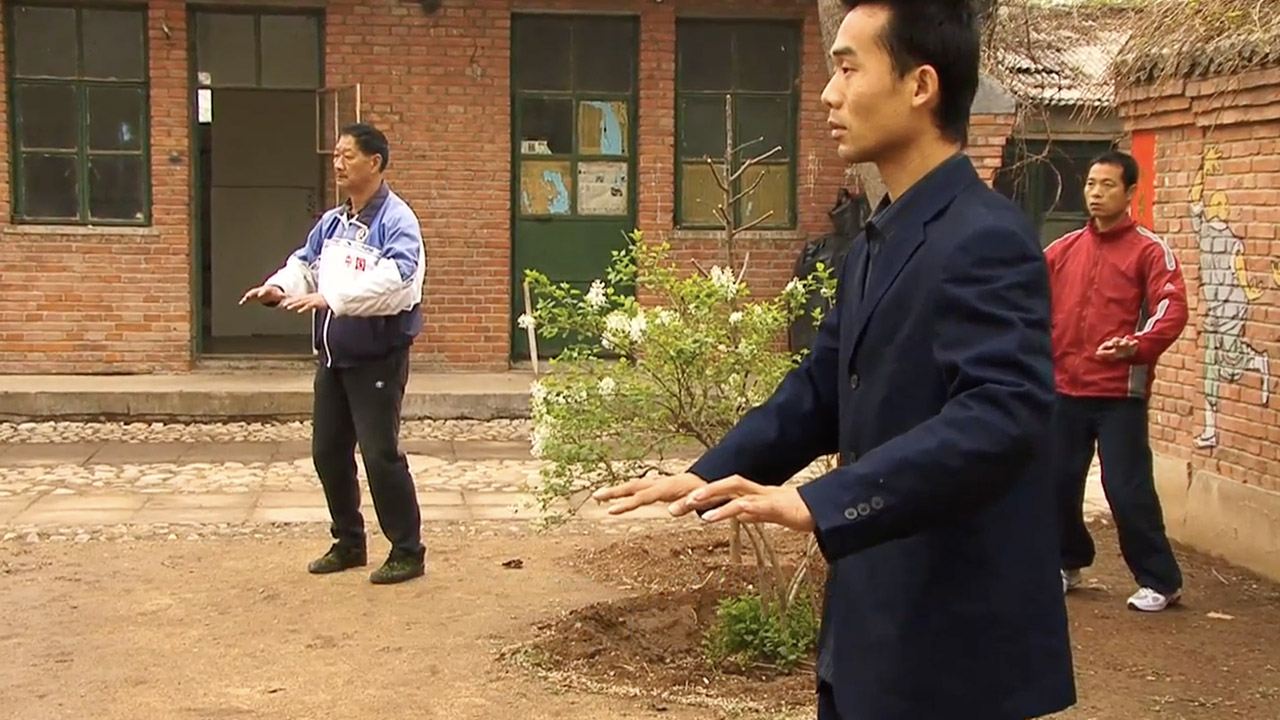
Master Cui Ruibin and students in standing pole or Zhan Zhuang
You can tell us about the daily training?
Cui Ruibin: We start our practice each day at 8am. The schedule of the training is 8am to 11:30am in the morning, and then from 2pm to 5pm in the afternoon. We practice every day, from Monday to Saturday, so six days every week. Sunday is a rest day. On Saturday afternoon, we normally end the training an hour early and we clean the yard. It is easy as the students just live in the dormitory of the school.
Gong Dong, assistant to sifu Cui Ruibin: That does not mean all the students must live here to receive the full-time training. We have some full-time students who live in the dormitory, but there are also some other students who just come here in their spare time. There are quite a few students who come here to get full-time long training, for periods of one month, two months, six months or even three or four years.
There is no condition on how long you can stay. For example, I came here to learn Yiquan from sifu and I have been here for more than 10 years now. I started practicing martial arts when I was seven or eight years old. We will arrange different training schedules for each students according to their condition. Here we teach traditional martial arts, and we strictly follow the guideline of the classes. Each student can get his class schedule according to their time here, and the class content is slightly different. The content of our martial arts classes is traditional, but our teaching method is quite modern and scientific.

Interview with assistant Gong Dong in the courtyard
Do you enter any Martial Arts competitions?
Cui Ruibin: We attend the martial arts competition according to the regulation of our country. This means the first step should be a healthy one. That is to say, some illnesses, especially chronic ones, need to be cured from the training before they can attend the competition. We have received good results in the competitions. Every year we have some students to get the gold medal, silver medal, bronze medal in the competition of Sanda (Sanshou or Kickboxing).
Gong Dong: We do also enter other competitions beside Sanda. For example, sifu attended the performance of Traditional Martial Arts Festival of the World. The first time we attended the national competition was in 1999. Since Yiquan has no fixed set of actions, it is very hard to comply with fixed competition rules, so we mainly attend the competition of Sanda. The country can acknowledge the style of Yiquan. My sifu also attended the Traditional Martial Arts Festival of the World on behalf of the Chinese national team, and we got the silver medal and the bronze medal.
We attended every year of the national competition of Sanda, and also the competition at the international level. We have already won the gold medal more than ten times.
Cui Ruibin: Our team members in the competition are formed mainly by “ill people”. What I mean to say, is they came to our school with some chronic disease, and through the training here, they can not only get healthy and much stronger, but can even attend the fight competition and get very good results.
Gong Dong: This is the difference between our school and others. Many of the students come here in a very weak condition, and get much stronger after the training. What’s more, after our training, they can master the ability to fight in competitions and can get good results. This is very different with other schools, often professional Sanda training schools. Most of our students are “ill people” and they get stronger after being in poor physical conditions.
What do you think of modern wushu that is often criticized for being like a dance?
Cui Ruibin: This is a normal phenomenon due to the market economy. We stick to the traditional essence of martial arts, yet at the same time, we keep up with the modern society. But we will stick to our unique character and not change just to be commercial. That will never change. We must follow the characteristic of traditional martial arts.
Look, it is like this. As a human being, we must survive first. We must have food. It makes no difference who we are. You, Jon are a westerner, while we are Chinese. Yet we all eat food every day, although we eat different food, we get the same nutrition to live. Now compare this to wushu and traditional martial arts in that although the styles are different, the essence is the same. The culture is the same, no matter which nationality.
There should be a good connection with both. Another example is people who are practicing in western medicine should not reject everything about Chinese medicine. Neither should the people practicing Chinese medicine reject foreign methods. Neither of them has its own advantages or disadvantage. This is like it is with martial arts.

Assistant Gong Dong teaching Tui Shou or pushing hands
Interview in the training ground.
Can you tell us what your students are doing?
Cui Ruibin: What the students are practicing here is standing meditation. After standing meditation, they will practice Shi Li (strength testing). There are many kinds of forms for Shi Li, including open and closed Shi Li, pushing and pulling Shi Li, moving up and moving down Shi Li, and Shi Li with movements same as a tortoise coming out of the water. After the practitioners practice Shi Li from a fixed-stance, they can practice Shi Li while moving with stepping, this is Shi Li practiced for the legs.
In the 4pm class, we will have different people practice different forms. According to their physical conditions, some practice Shi Li, some practice Moca Bu (friction stepping), and some practice fist forms and Tui Shou (pushing hands).
Can you explain standing meditation and how it functions?
Cui Ruibin: In simple terms, Zhan Zhuang (standing meditation) is a kind of physical practice that has no external movements, but has internal movement. The movements are done through the leading of the mind and nervous system. The qi and blood and vessels in the body can get a very good exercise.
The method of Zhan Zhuang we practice was created by Mr. Wang Xiangzhai, who inherited it from former generations and made some further developments. My master is Mr. Yao Zongxun, who inherited his Zhan Zhuang methods from Wang Xiangzhai. This way of practice can date back to 5,000 years ago. At that time, Huang Emperor asked Guang Chengzi (an immortal in ancient China) for his knowledge of health preservation methods. He knelt down on the ground on his knees at the edge of Guang’s bed. Guang Chengzi just taught him this practicing method.
Standing meditation is a modern name for this method, at that time, it was called “standing alone and keeping the spirit.” This comes from the common phrase at the time, ”standing alone and keeping the spirit, living with the changing rule of the world and yin and yang, and integrating the muscles as one.” It is a very good exercise to practice, especially for people with chronic disease. If a sick person persists in this practice for some time, their physical condition will get an obvious improvement.
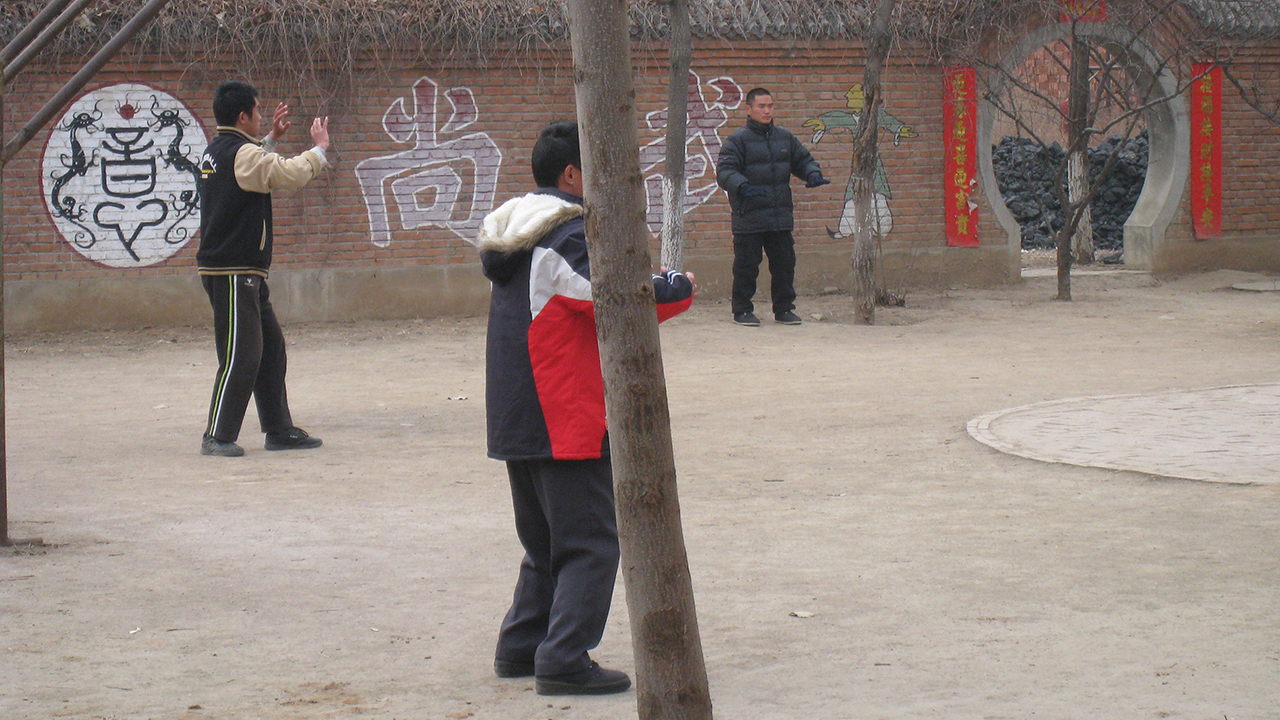
Students in standing pole or Zhan Zhuang
What is the purpose of Zhan Zhuang?
Gong Dong: Through these practices, people can reach a skill that allows them to control the brain. What is it that we want to control? To control the movements, and through practice, we can make the movements more coordinated. The more coordinated the movements are, the better they are for the explosion of the power. So the practicing method of Yiquan is quite different from most other martial arts practice, which usually start from some forms (movement), but Yiquan just starts from Zhan Zhuang (standing meditation). Zhan Zhuang is the access we use in Yiquan. Actually every style of martial arts in China have Zhan Zhuang (standing meditation), it is just that Yiquan regards Zhan Zhuang as the core technique and lifts it to the most important status. All the practice of Yiquan are based on Zhan Zhuang (standing meditation).
What are the students doing at the start of class?
Cui Ruibin: So here you can now see the students are practicing the most basic and most important skill of Yiquan, Zhan Zhuang (standing meditation), which has many forms. With regard to the health-preservation aspect, the form changes according to the degree of the disease and physical conditions of the individual. It has different postures. The postures are designed according to different illness. Also with respect to fighting, the postures are different too, including the way we step.
In essence, standing meditation is the most basic training method of traditional martial arts. It has no complicated forms, just taking standing meditation as its basic training method. Through standing meditation, a practitioner can find real strength of their fist forms. We also call this Hunyuan power (whole body force). Without mastering the foundation of s Zhan Zhuang (standing meditation), there is no way for one’s practice to progress.

Strength testing or Shi Li, can be moving up and moving down
Can you talk about the posture?
Gong Dong: Yes, the students look like they are standing still and not move at all. But when they stand there, they are required to have high concentration and focus. In the aspect of fighting function, that is high concentration. The body should be relaxed to feel comfortable and steady, and keeping the breath natural. On the basis of these principles, they add related mind movements to guide the physical movements.
We do not see any movements?
Gong Dong: I understand. I am referring to the movement of the mind. For example, if a student practices the kind of Zhan Zhuang (standing meditation) named Fu’an movement (pressing and raising hands), they will have some related movements with their mind. They can imagine themselves standing in water. You can visualize a wood board on the surface of the water, and putting your hands on the board and feeling it. This relies on the mind totally. We are not really physically do the movements. So Zhan Zhuang looks still, but the mind is practicing during this time.
Some practitioners imagine they are holding a balloon in front of them. Some imagine they are holding or hugging a tree trunk. There are many kinds of mind practice. It is not just standing there doing nothing. It appears they have no movements at all, but the mind keeps working, no matter if it is holding the tree, or touching the boards or pulling silk cloth. There are many kinds of related mind practice.
Is there any kind of physical movements as well?
Gong Dong: Yes, you can start from these kinds of standing meditation. You can start with the simplest, or we can not say it is the simplest, just because it is easier to practice. So at the beginning, the level is low, it is simple. After you practice it very well, you can practice more complicated forms. Then afterward, you can practice with regular steps. After this and depending on the student’s level, you can practice some fighting forms or San Shou (free sparring). The student should improve this way, step by step.
Zhan Zhuang (standing meditation) is the most important skill of Yiquan. Just like people have meals everyday, if you practice Yiquan, you should practice standing meditation everyday.

Practicing fighting forms such as Tui Shou or pushing hands
Beside standing meditation, what will the students practice today?
Gong Dong: They always practice standing meditation every morning and afternoon. About seventy minutes for each time. Then for the rest time, the students practice friction steps, Zou Bu (stepping) Shi Li (strength testing), Fa Li (explosive power), fist, sand bag, and fighting forms, such as Tui Shou (pushing hands), a series of practices. We make weekly plans of the training methods and schedules. The teachers will teach students relative forms according to the level of the students.
After you sense some feelings through Zhan Zhuang (standing meditation), you should check whether you still hold the feelings when making some physical movements. So, now they will transfer from stillness to movement. This stillness is just relative stillness, because according to materialism, stillness is also a kind of movement in special form. Yiquan develops this kind of still practice to the extent that make the practitioners get some internal movements while standing still. What do the internal movements rely on? First of all, it starts with the mind. That is to say, the imagination of the mind. For example, when we stand here in Zhan Zhuang, there is no water at all. We just imagine the water with the mind. There is no board either, this also comes from the imagination. So we call it mind imagination.
After you start to use imagination, you use mind guidance, where you have the physical movements of putting the hands on the board. You are not really doing this but just thinking about it. So it relies on mind imagination and mind guidance. We usually call it mind movement.
What about the health benefits of Yiquan?
Cui Ruibin: Beside its strong fighting function, and the practice of Hunyuan Power, Yiquan also has a great function in health-preservation. We say “cure the disease, and make the healthy even stronger.” Yiquan has very good curative effect on almost all of the chronic diseases, and the effects can be seen now after decades of years of practice. For example, in the diseases of the heart and the blood vessels, cervical vertebrae, and high blood pressure, diabetes, gall stones and kidney stones. People with a disease who are sick, can have very good curative effects through standing meditation. We have a student here with liver ascites, that is both cirrhosis and ascites, which was cured. We also have students with lung problems, diabetes, and also bronchitis. So our students through Yiquan practice, some practice half a year, some one year or practice two years, according to the level of their disease, can recover and become more healthy.
The most important benefit of Yiquan, beside its strong fighting aspect, is the health-preservation. We can explore this with more potential as it is very simple to practice, just standing there is all you need. It does not require the practitioners have very good physical condition. As long as you keep practicing each day, you can get very good results.




